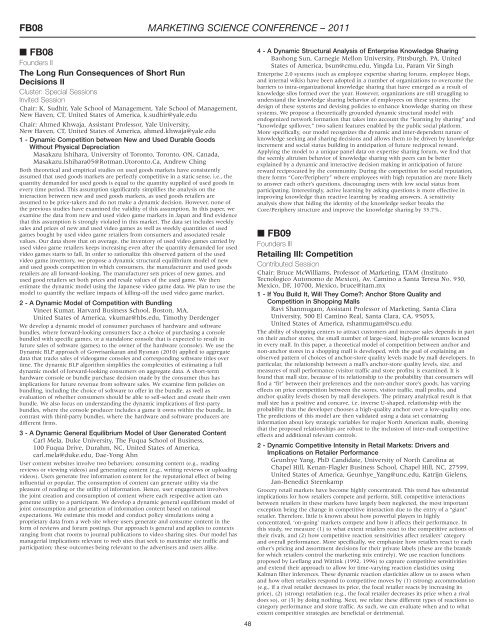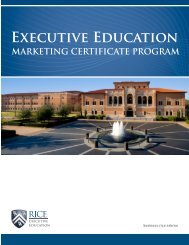Conference Sessions - Jesse H. Jones Graduate School of ...
Conference Sessions - Jesse H. Jones Graduate School of ...
Conference Sessions - Jesse H. Jones Graduate School of ...
You also want an ePaper? Increase the reach of your titles
YUMPU automatically turns print PDFs into web optimized ePapers that Google loves.
FB08 MARKETING SCIENCE CONFERENCE – 2011<br />
■ FB08<br />
Founders II<br />
The Long Run Consequences <strong>of</strong> Short Run<br />
Decisions II<br />
Cluster: Special <strong>Sessions</strong><br />
Invited Session<br />
Chair: K. Sudhir, Yale <strong>School</strong> <strong>of</strong> Management, Yale <strong>School</strong> <strong>of</strong> Management,<br />
New Haven, CT, United States <strong>of</strong> America, k.sudhir@yale.edu<br />
Chair: Ahmed Khwaja, Assistant Pr<strong>of</strong>essor, Yale University,<br />
New Haven, CT, United States <strong>of</strong> America, ahmed.khwaja@yale.edu<br />
1 - Dynamic Competition between New and Used Durable Goods<br />
Without Physical Depreciation<br />
Masakazu Ishihara, University <strong>of</strong> Toronto, Toronto, ON, Canada,<br />
Masakazu.Ishihara05@Rotman.Utoronto.Ca, Andrew Ching<br />
Both theoretical and empirical studies on used goods markets have consistently<br />
assumed that used goods markets are perfectly competitive in a static sense, i.e., the<br />
quantity demanded for used goods is equal to the quantity supplied <strong>of</strong> used goods in<br />
every time period. This assumption significantly simplifies the analysis on the<br />
interaction between new and used goods markets, as used goods retailers are<br />
assumed to be price-takers and do not make a dynamic decision. However, none <strong>of</strong><br />
the previous studies have examined the validity <strong>of</strong> this assumption. In this paper, we<br />
examine the data from new and used video game markets in Japan and find evidence<br />
that this assumption is strongly violated in this market. The data set includes weekly<br />
sales and prices <strong>of</strong> new and used video games as well as weekly quantities <strong>of</strong> used<br />
games bought by used video game retailers from consumers and associated resale<br />
values. Our data show that on average, the inventory <strong>of</strong> used video games carried by<br />
used video game retailers keeps increasing even after the quantity demanded for used<br />
video games starts to fall. In order to rationalize this observed pattern <strong>of</strong> the used<br />
video game inventory, we propose a dynamic structural equilibrium model <strong>of</strong> new<br />
and used goods competition in which consumers, the manufacturer and used goods<br />
retailers are all forward-looking. The manufacturer sets prices <strong>of</strong> new games, and<br />
used good retailers set both prices and resale values <strong>of</strong> the used game. We then<br />
estimate the dynamic model using the Japanese video game data. We plan to use the<br />
model to quantify the welfare impacts <strong>of</strong> killing-<strong>of</strong>f the used video game market.<br />
2 - A Dynamic Model <strong>of</strong> Competition with Bundling<br />
Vineet Kumar, Harvard Business <strong>School</strong>, Boston, MA,<br />
United States <strong>of</strong> America, vkumar@hbs.edu, Timothy Derdenger<br />
We develop a dynamic model <strong>of</strong> consumer purchases <strong>of</strong> hardware and s<strong>of</strong>tware<br />
bundles, where forward-looking consumers face a choice <strong>of</strong> purchasing a console<br />
bundled with specific games, or a standalone console that is expected to result in<br />
future sales <strong>of</strong> s<strong>of</strong>tware (games) to the owner <strong>of</strong> the hardware (console). We use the<br />
Dynamic BLP approach <strong>of</strong> Gowrisankaran and Rysman (2010) applied to aggregate<br />
data that tracks sales <strong>of</strong> videogame consoles and corresponding s<strong>of</strong>tware titles over<br />
time. The dynamic BLP algorithm simplifies the complexities <strong>of</strong> estimating a full<br />
dynamic model <strong>of</strong> forward-looking consumers on aggregate data. A short-term<br />
hardware console or bundle purchase decision made by the consumer thus has<br />
implications for future revenue from s<strong>of</strong>tware sales. We examine firm policies on<br />
bundling, including the choice <strong>of</strong> s<strong>of</strong>tware to <strong>of</strong>fer in the bundle, as well as<br />
evaluation <strong>of</strong> whether consumers should be able to self-select and create their own<br />
bundle. We also focus on understanding the dynamic implications <strong>of</strong> first-party<br />
bundles, where the console producer includes a game it owns within the bundle, in<br />
contrast with third-party bundles, where the hardware and s<strong>of</strong>tware producers are<br />
different firms.<br />
3 - A Dynamic General Equilibrium Model <strong>of</strong> User Generated Content<br />
Carl Mela, Duke University, The Fuqua <strong>School</strong> <strong>of</strong> Business,<br />
100 Fuqua Drive, Durahm, NC, United States <strong>of</strong> America,<br />
carl.mela@duke.edu, Dae-Yong Ahn<br />
User content websites involve two behaviors; consuming content (e.g., reading<br />
reviews or viewing videos) and generating content (e.g., writing reviews or uploading<br />
videos). Users generate free information content for the reputational effect <strong>of</strong> being<br />
influential or popular. The consumption <strong>of</strong> content can generate utility via the<br />
pleasure <strong>of</strong> reading or the utility <strong>of</strong> information. Hence, user engagement involves<br />
the joint creation and consumption <strong>of</strong> content where each respective action can<br />
generate utility to a participant. We develop a dynamic general equilibrium model <strong>of</strong><br />
joint consumption and generation <strong>of</strong> information content based on rational<br />
expectations. We estimate this model and conduct policy simulations using a<br />
proprietary data from a web site where users generate and consume content in the<br />
form <strong>of</strong> reviews and forum postings. Our approach is general and applies to contexts<br />
ranging from chat rooms to journal publications to video sharing sites. Our model has<br />
managerial implications relevant to web sites that seek to maximize site traffic and<br />
participation; these outcomes being relevant to the advertisers and users alike.<br />
48<br />
4 - A Dynamic Structural Analysis <strong>of</strong> Enterprise Knowledge Sharing<br />
Baohong Sun, Carnegie Mellon University, Pittsburgh, PA, United<br />
States <strong>of</strong> America, bsun@cmu.edu, Yingda Lu, Param Vir Singh<br />
Enterprise 2.0 systems (such as employee expertise sharing forums, employee blogs,<br />
and internal wikis) have been adopted in a number <strong>of</strong> organizations to overcome the<br />
barriers to intra-organizational knowledge sharing that have emerged as a result <strong>of</strong><br />
knowledge silos formed over the year. However, organizations are still struggling to<br />
understand the knowledge sharing behavior <strong>of</strong> employees on these systems, the<br />
design <strong>of</strong> these systems and devising policies to enhance knowledge sharing on these<br />
systems. We propose a theoretically grounded dynamic structural model with<br />
endogenized network formation that takes into account the “learning by sharing” and<br />
“knowledge spillover,” two salient features enabled by the public social platform.<br />
More specifically, our model recognizes the dynamic and inter-dependent nature <strong>of</strong><br />
knowledge seeking and sharing decisions and allows them to be driven by knowledge<br />
increment and social status building in anticipation <strong>of</strong> future reciprocal reward.<br />
Applying the model to a unique panel data on expertise sharing forum, we find that<br />
the seemly altruism behavior <strong>of</strong> knowledge sharing with peers can be better<br />
explained by a dynamic and interactive decision making in anticipation <strong>of</strong> future<br />
reward reciprocated by the community. During the competition for social reputation,<br />
there forms “Core/Periphery” where employees with high reputation are more likely<br />
to answer each other’s questions, discouraging users with low social status from<br />
participating. Interestingly, active learning by asking questions is more effective in<br />
improving knowledge than reactive learning by reading answers. A sensitivity<br />
analysis show that hiding the identity <strong>of</strong> the knowledge seeker breaks the<br />
Core/Periphery structure and improve the knowledge sharing by 35.7%.<br />
■ FB09<br />
Founders III<br />
Retailing III: Competition<br />
Contributed Session<br />
Chair: Bruce McWilliams, Pr<strong>of</strong>essor <strong>of</strong> Marketing, ITAM (Instituto<br />
Tecnologico Autonomo de Mexico), Av. Camino a Santa Teresa No. 930,<br />
Mexico, DF, 10700, Mexico, bruce@itam.mx<br />
1 - If You Build It, Will They Come?: Anchor Store Quality and<br />
Competition in Shopping Malls<br />
Ravi Shanmugam, Assistant Pr<strong>of</strong>essor <strong>of</strong> Marketing, Santa Clara<br />
University, 500 El Camino Real, Santa Clara, CA, 95053,<br />
United States <strong>of</strong> America, rshanmugam@scu.edu<br />
The ability <strong>of</strong> shopping centers to attract customers and increase sales depends in part<br />
on their anchor stores, the small number <strong>of</strong> large-sized, high-pr<strong>of</strong>ile tenants located<br />
in every mall. In this paper, a theoretical model <strong>of</strong> competition between anchor and<br />
non-anchor stores in a shopping mall is developed, with the goal <strong>of</strong> explaining an<br />
observed pattern <strong>of</strong> choices <strong>of</strong> anchor-store quality levels made by mall developers. In<br />
particular, the relationship between a mall’s anchor-store quality levels, size, and<br />
measures <strong>of</strong> mall performance (visitor traffic and store pr<strong>of</strong>its) is examined. It is<br />
found that mall size, because <strong>of</strong> its relationship to the probability that consumers will<br />
find a “fit” between their preferences and the non-anchor store’s goods, has varying<br />
effects on price competition between the stores, visitor traffic, mall pr<strong>of</strong>its, and<br />
anchor quality levels chosen by mall developers. The primary analytical result is that<br />
mall size has a positive and concave, i.e. inverse U-shaped, relationship with the<br />
probability that the developer chooses a high-quality anchor over a low-quality one.<br />
The predictions <strong>of</strong> this model are then validated using a data set containing<br />
information about key strategic variables for major North American malls, showing<br />
that the proposed relationships are robust to the inclusion <strong>of</strong> inter-mall competitive<br />
effects and additional relevant controls.<br />
2 - Dynamic Competitive Intensity in Retail Markets: Drivers and<br />
Implications on Retailer Performance<br />
Geunhye Yang, PhD Candidate, University <strong>of</strong> North Carolina at<br />
Chapel Hill, Kenan-Flagler Business <strong>School</strong>, Chapel Hill, NC, 27599,<br />
United States <strong>of</strong> America, Geunhye_Yang@unc.edu, Katrijn Gielens,<br />
Jan-Benedict Steenkamp<br />
Grocery retail markets have become highly concentrated. This trend has substantial<br />
implications for how retailers compete and perform. Still, competitive interactions<br />
between retailers in these markets have largely been neglected, the most important<br />
exception being the change in competitive interaction due to the entry <strong>of</strong> a “giant”<br />
retailer. Therefore, little is known about how powerful players in highly<br />
concentrated, ‘on-going’ markets compete and how it affects their performance. In<br />
this study, we measure (1) to what extent retailers react to the competitive actions <strong>of</strong><br />
their rivals, and (2) how competitive reaction sensitivities affect retailers’ category<br />
and overall performance. More specifically, we emphasize how retailers react to each<br />
other’s pricing and assortment decisions for their private labels (these are the brands<br />
for which retailers control the marketing mix entirely). We use reaction functions<br />
proposed by Leeflang and Wittink (1992, 1996) to capture competitive sensitivities<br />
and extend their approach to allow for time-varying reaction elasticities using<br />
Kalman filter inferences. These dynamic reaction elasticities allow us to assess when<br />
and how <strong>of</strong>ten retailers respond to competitive moves by (1) (strong) accommodation<br />
(e.g., if a rival retailer decreases its price, the focal retailer reacts by increasing its<br />
price), (2) (strong) retaliation (e.g., the focal retailer decreases its price when a rival<br />
does so), or (3) by doing nothing. Next, we relate these different types <strong>of</strong> reactions to<br />
category performance and store traffic. As such, we can evaluate when and to what<br />
extent competitive strategies are beneficial or detrimental.

















